
This site uses cookies, by continuing to use this site you accept the terms of our privacy policy
Feed 2.0 Loading...
FloWave Test Tank Facility Can Simulate Pentland Firth Conditions
9th April 2014
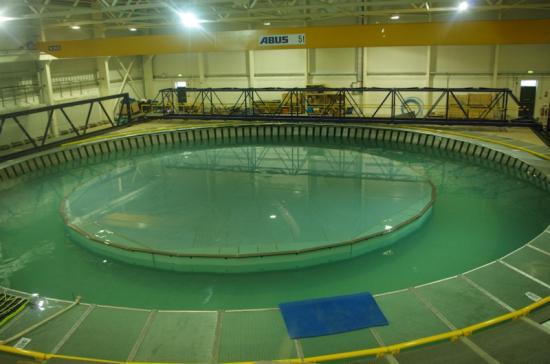
EDINBURGH UNIVERSITY'S MULTI-MILLION POUND BRAND-NEW 'FloWave TT' FACILITY IS A WORLD-LEADER THAT CAN SIMULATE ACTUAL PENTLAND FIRTH WAVE AND TIDAL SEA-CONDITIONS.
One of the biggest and most complex scientific instruments ever devised and built in Scotland will be 'in commercial action' for the first time this Spring (2014) at its site near Blackford Hill in Edinburgh.
Early tests have proven that the unique £13 million huge 'International All-Waters Combined Current and Wave Test Facility' (popularly known as the FloWave Test Tank) will be able to replicate the natural, but sometimes extreme, varying sea-conditions of key parts of the Pentland Firth at different stages of the twice-daily tidal cycle and with different 'incoming' wave-heights.
This will be 'on a controllable laboratory scale' and with a realistic complexity that has never previously been attempted nor seen, with FloWave TT hopefully playing a substantial part in efforts to devise the most efficient and reliable means of electricity generation from both tidal streams and waves.
Edinburgh University's world-leading FloWave TT onshore test facility, at its KIngs Buildings Science & Engineering Campus, can model the effects of swift-flowing sea-currents combined with big multi-directional swells in a laboratory scale. The circular tank, with a diameter of 30 metres, holds more water than Edinburgh's famous Royal Commonwealth Pool.
The aim of the brand-new FloWave TT is to aid the design of prototype turbines and associated devices and to speed-up the adoption of those being conceived for extracting large quantities of 'marine electricity' from the kinetic energy in the tide-streams, such as the Pentland Firth, in the future. This will be regularly done at a scale of 1/40 and FloWave TT is being seen as both cutting the cost and risk of the pre-production stage.
Bill Mowat , Chairman of community-owned Gills Harbour Ltd, has just been given a preview of FloWave TT 'in action' during its final commissioning trials.
Gills Harbour lies on the doorstep of the Pentland Firth tide-streams, where the first demonstration array is planned to be installed 'in the water' on the 30-metre deep seabed of its Inner Sound during next year (2015), The visit for the small group of Edinburgh University graduates was organised by Helmsdale-born Lady Muir Russell (nee Ms Eileen Mackay), a former top-level civil servant who is now a Governor of the Court of the University of the Highlands & Islands (UHI), who has Caithness family links.
The UHI, which includes its Thurso-centred North Highland College, recently appointed Scottish tidal-energy pioneer Professor Ian Bryden as it new Vice Principal, with overall responsibility for its research programmes.
Dumfries-shire born Prof Bryden who, until late 2013 headed Edinburgh University's Institute for Energy Systems, played a key part in the conception, fund-raising and building of FloWave TT; he is a director of FloWave TT Ltd, the Edinburgh University-owned company that owns and operates it and he also holds a non-executive board position at the European Marine Energy Centre (EMEC) in Orkney where prototype tidal turbines are tested in the powerful sea-currents of the Falls of Warness, off Eday, Orkney.
The massive circular tank is housed inside a purpose-built, highly-insulated building erected by Graham Construction of Belfast, Northern Ireland, a firm best-known in Caithness for constructing the 'low active' storage vaultsat Dounreay for Dounreay Site Regeneration Ltd (DSRL).
FloWave TT is ringed by a series of high-tech, computer-controlled, devices for producing currents and making waves, all of which can act independently, most of which have been supplied by Edinburgh Designs Ltd. It is the World's first marine test facility to be able to simulate normal and extreme conditions of waves and tidal-streams in combination.
Water can be pumped across the tank to an equivalent speed of up to 15 knots (0.8 metres per second). while 'model' waves can rear up to as much as 28 metres, while an overhead crane can precisely load devices into its circular 17-metre test zone; there is a wider surrounding 'curtain' aimed at keeping wave-refraction to near-zero, if required.
In his introductory remarks, FloWave TT's chief executive Mr Stuart Brown revealed that a deal has already been done for a share of data with EMEC's wave and tidal sites in Orkney, so that it can replicate actual sea conditions at Falls of Warness and at Billia Croo, iEMEC's 'wave converter' test -site in near-shore sea off Orkney's West Mainland, near Stromness.
The extended programme of 'Acoustic Doppler Current Profilers' (ADCPs) undertaken in 2013/14 under the waters of the Inner Sound by Exeter University scientists and engineers, has had a main purpose of relating actual conditions between Gills Bay and Stroma Island to those at EMEC's Eday sea-site, where full-scale prototypes of the turbines to be used have undergone testing.
Mr Stuart Brown said that FloWave TT can 'easily simulate extreme storm events in a calculated and controlled manner' to let turbine designs be improved before these are expensively tested in the water and so allow some problems to be solved before actual deployment; in other words, it will allow costs be cut, as well as reducing the chances of component failure.
The FloWave TT is managed by a not-for-profit subsidiary of the University of Edinburgh and was substantially funded through the UK's Engineering & Physical Sciences Research Council.
It can simulate sea-conditions anywhere in waters around Europe's entire Continental Shelf and could find possible uses in cost-reduction exercises for offshore wind-farms or deep-water oil & gas recovery systems, although electricity from the tides and waves have been the driving forces in its creation.
Chief Technician Mr Thomas Davey then put it through its paces, including simulation of multi-directional waves that are a feature of phenomena such as the Merry Men of Mey.
Yesterday Mr Mowat said : 'It has been a privilege to see this unique, Scottish, tool for tidal stream research and development in action during a pre-commercial test. It will become available to the nascent tidal industry within the next month or two.
'I have repeatedly said that Pentland Firth 'tidal stream electricity' will only become a long-term industry for Caithness, rather than a 'flash in the pan', IF costs can be significantly reduced with safety standards being retained or enhanced.
'We at Gills Harbour Ltd are determined to play a part of this, for much wider benefit.
'FloWave TT is showing that there is more than one way of metaphorically 'skinning a cat' and thanks to Professor Bryden and his team, Scotland now has a unique facility to help in this 'commercialisation' process.
'In future, there could be even be safety benefits in testing precision scale-models of standard multi-cat vessels actually known to be favoured in turbine-deployment in extreme conditions here to cut the risks to on-board technicians and crews to the absolute minimum'.
Related Businesses
Related Articles
21/10/2022
Three Cats At Gills Harbour
Two catamaran work-boats berthed at Gills Harbour this week with the trans-Pentlnd ferry MV Alfred, also a catamaran, in the background. The larger workboat is MPC Athenia which was being used as a floating base or ROVs - remote underwater vessels, for detailed inspections on the three turbines operating at the MeyGen demonstration subsea site one and a half miles off Gills Harbour.
12/6/2022
GILLS HARBOUR Ltd ANNUAL GENERAL MEETING
GILLS HARBOUR Ltd - ANNUAL GENERAL MEETING at JOHN O'GROATS VILLAGE HALL, MONDAY JUNE 13th @ 7.30 PM. GILLS HARBOUR IS THE ONLY OFFICIALLY-RECOGNISED 'ECONOMIC DEVELOPMENT AREA' IN NE CAITHNESS.22/3/2021
Latest Boats At Gills Harbour For Work At Meygen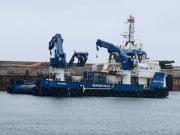
£10 million 'Isle of Jura' temporarily based at Gills Harbour in Far North of Scotland for her crew's debut tasks in the tidal-stream electricity field at the MeyGen sub-sea site, one mile off the little Caithness's port entrance channel. One of the UK's most modern marine renewables service vessels made her debut calls at community-owned Gills Harbour, near John O'Groats, over the 2021 Spring Equinoctial weekend.
23/2/2021
Busy Gills Harbour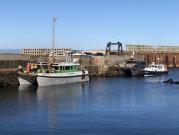
Its been a busy few days at local community-owned Gills Harbour ..... sometimes in suberb sunny weather as here ...
26/11/2020
Energy Developments Continue at Gills Harbour and the Pentland Firth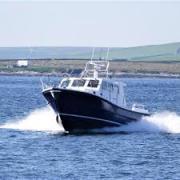
The company behind the world-leading tidal-stream prototype power plant in the Pentland Firth's Inner Sound is set to start manufacturing a new-style turbine that is hopes will reduce the project's generating costs. Simec Atlantis Energy (SAE) and a privately-owned specialist engineering firm from Spain's Bay of Biscay coastline have jointly been conducting 'research and development' (R& D) on the project for almost a year and are now ready to give it the go-ahead.
8/10/2020
New Generation of office-bearers set to step up at Gills Harbour Ltd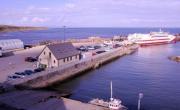
A new generation of younger local folk look set to take over the reins of running Gills Harbour Ltd, the local company that owns and operates the busy little port on the shores of the Pentland Firth's Inner Sound that holds its AGM this Saturday (10.10.20) morning at 10:00 am. The influx of younger blood comes after two key directors of the group that had run 'Canisbay's Peoples Port' both announced their retirement from office, whilst another Gills Harbour Ltd (GHL) office-bearer has declined to seek re-election.
19/8/2020
MV Alfred And MV Pentalina Together At Gills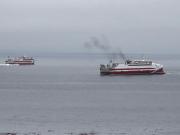
An 'old friend' returns to Gills Bay after an absence of manymonths. The 2,400 tonne 70 m.
16/8/2020
Normand Cutter, The Norwegian-owned Offshore Construction Vessel at Gills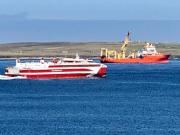
Here is the Normand Cutter, the Norwegian-owned offshore construction vessel that has been the base for works on Simec Atlantis Energy's (SAE's) MeyGen site in the Pentland Firth's Inner Sound, off Gills Bay during the current neap-tide sequence, that has lasted most of the week commencing 11.08.20. Picture by retired C of S Kirk Minister the Rev Lyall Rennie, who lives at Lower Warse, Canisbay, on the shores of Gills Bay..
9/10/2019
New Ferry For Pentland Ferries Arrives Safely
Scotland's most modern + environmentally-friendly, fuel-efficient ROPAX ferry ship rge MV Alfred, arrived AM today (Wed 09.10.19 at St Margarets Hope. The boat went round to Kirkwall immediately at the end of 9,000+ miles voyage from the Strategic Marine yard near Ho Chi Minh city (ex.
20/3/2019



